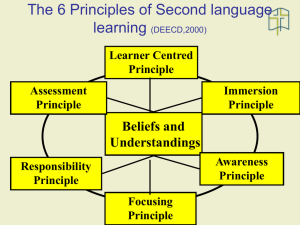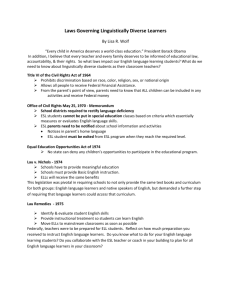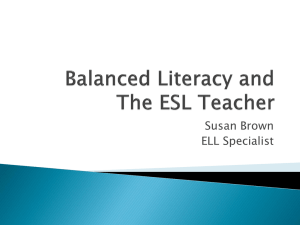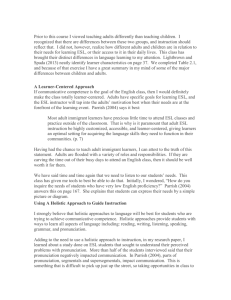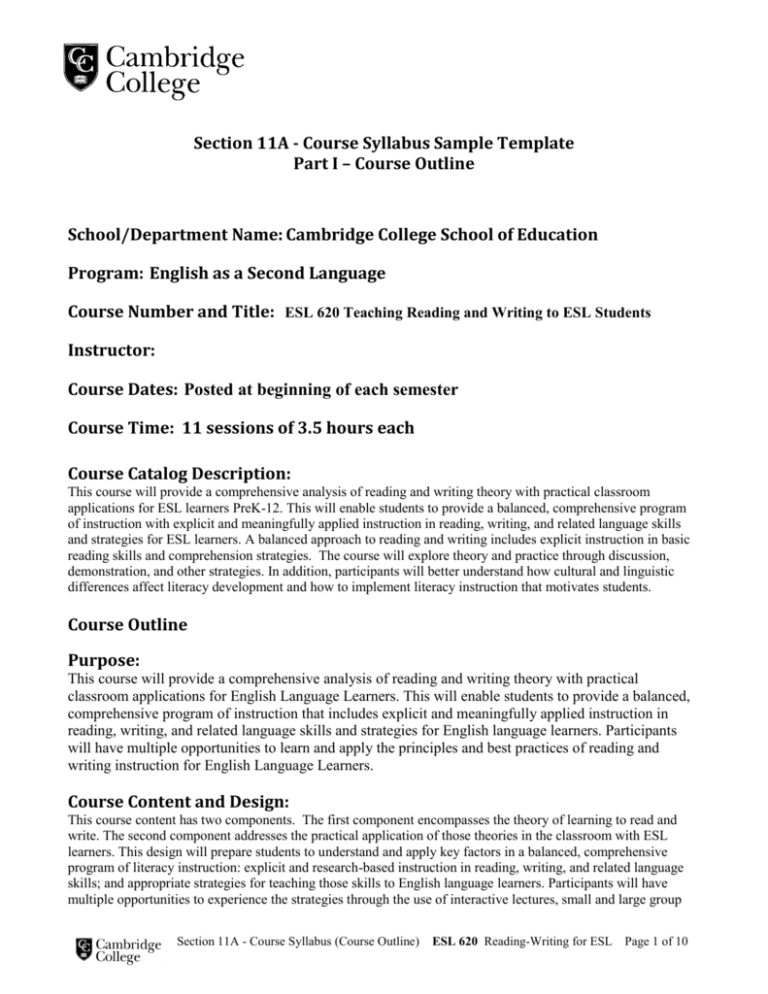
Section 11A - Course Syllabus Sample Template
Part I – Course Outline
School/Department Name: Cambridge College School of Education
Program: English as a Second Language
Course Number and Title: ESL 620 Teaching Reading and Writing to ESL Students
Instructor:
Course Dates: Posted at beginning of each semester
Course Time: 11 sessions of 3.5 hours each
Course Catalog Description:
This course will provide a comprehensive analysis of reading and writing theory with practical classroom
applications for ESL learners PreK-12. This will enable students to provide a balanced, comprehensive program
of instruction with explicit and meaningfully applied instruction in reading, writing, and related language skills
and strategies for ESL learners. A balanced approach to reading and writing includes explicit instruction in basic
reading skills and comprehension strategies. The course will explore theory and practice through discussion,
demonstration, and other strategies. In addition, participants will better understand how cultural and linguistic
differences affect literacy development and how to implement literacy instruction that motivates students.
Course Outline
Purpose:
This course will provide a comprehensive analysis of reading and writing theory with practical
classroom applications for English Language Learners. This will enable students to provide a balanced,
comprehensive program of instruction that includes explicit and meaningfully applied instruction in
reading, writing, and related language skills and strategies for English language learners. Participants
will have multiple opportunities to learn and apply the principles and best practices of reading and
writing instruction for English Language Learners.
Course Content and Design:
This course content has two components. The first component encompasses the theory of learning to read and
write. The second component addresses the practical application of those theories in the classroom with ESL
learners. This design will prepare students to understand and apply key factors in a balanced, comprehensive
program of literacy instruction: explicit and research-based instruction in reading, writing, and related language
skills; and appropriate strategies for teaching those skills to English language learners. Participants will have
multiple opportunities to experience the strategies through the use of interactive lectures, small and large group
Section 11A - Course Syllabus (Course Outline)
ESL 620 Reading-Writing for ESL
Page 1 of 10
instruction, lesson plan presentations, reflections, analysis of videos and podcasts, and cooperative learning
activities. Course assignments are designed to enable students to target the grade level (PreK-6, 5-12, or Adult) at
which they teach, or plan to teach.
Course Requirements:
1. Attendance (Mandatory) and Class Participation (20%)
2. 8 Inquiry Reflections (30%):
Inquiry reflections are one or two page, single-spaced written responses to readings from textbooks or articles.
These reflections are intended to help focus your reactions to the course's readings and to facilitate our in-class
discussion. A reflection consists of two parts: Part 1 summarizes, in your own words, the most important ideas
from the reading. Part 2 should provide a reflective response, i.e. What did you agree/disagree with? What are the
implications for ELL instruction? What new ideas might you try with students? What questions/thoughts do you
have as a result of this inquiry reading? (Cite specific examples from the text, including page number.)
3. Informal Reading Inventory (20%)
You will observe how an ELL student interacts with a required text from your content area. Using a text from
your classroom, the student will read a passage while you keep track of words the student has difficulty reading.
You will follow the text as the student reads and mark errors and miscues. When the student is finished reading,
you will check comprehension by having the student retell in his/her own words what the selection is about. You
will prepare a brief summary of what you learned about your ELL student’s reading strengths and challenges and
how you will use this knowledge to plan instruction.
4. Final Products (30%)
One SEI lesson plan and reflection for reading, applicable to your current teaching assignment.
One SEI lesson plan and reflection for writing, applicable to your current teaching assignment.
Lesson plan template will be provided.
Calendar of Course Assignments (Sample, Subject to Change)
Assignments
1. Reading/Reflection of ELL article from Am. Educator
2. Jigsaw Summary of Chamot and O’Malley article
3. Reading/Reflection, Chapter 6, Vocabulary Development
4. Reading/Reflection, Chapter 7, ELLs and Process Writing
5. Lesson Plan that incorporates a writing strategy (any strategy described in the book, or
modeled in videos in www.myeducationlab.com)
6. Reading/Reflection, Chapter 8, Reading and Literature Instruction for ELLs
7. Reading/Reflection, Chapter 9, Content Reading and Writing; Prereading and During
Reading
8. Reading/Reflection, Chapter 10, Content Reading and Writing, Postreading
9. Lesson Plan that incorporates a reading strategy. (You may use any of the strategies
described in the book, or modeled in videos in www.myeducationlab.com)
10. Chapter 11. Reading Assessment and Instruction,
Informal Reading Inventory
Write a reflection that summarizes what you learned about the student and how you will use
this information to plan instruction.
Due Date
Pre-Practicum: Early field based experiences in a variety of diverse settings, integrated into
courses or seminars that address either the Professional Standards for Teachers as set forth in 603
Section 11A - Course Syllabus (Course Outline)
ESL 620 Reading-Writing for ESL
Page 2 of 10
CMR 7.08 or the Professional Standards for Administrators as set forth in 603 CMR 7.00. For
candidates serving an apprenticeship or employed as educator of record, these experiences may
occur simultaneously with the practicum or the practicum equivalent
Faculty Pre-Practicum Assignment
Classroom observations and assignments will total 15 hours.
1. Conduct an Informal Reading Inventory (IRI) with a minimum of 2 students (ELLs, if possible).
Write a report that summarizes what you learned about each student and how you would use this
information to plan instruction for each student.
2. Observe in an ESL or SEI ELA secondary classroom, or a SEI elementary literacy block for
evidence of Sheltered English Instruction strategies and/or differentiation that supports ELLs.
3. Observe in an ESL or SEI secondary content area classroom, or SEI elementary content class
(Math, Science, Social Studies, etc.) for evidence of Sheltered English Instruction strategies
and/or differentiation that supports ELLs.
4. Write two separate reports for #2 and 3 that include…
(a) A description of the strategies and activities you observed that supported reading and/or
writing for ESL students.
(b) Strengths and challenges of the lesson for ESL students.
(c) How well the ESL students were able to participate in the lesson.
(d) How the teacher checked for understanding throughout the lesson.
(e) Your questions and suggestions for the lessons you observed.
Strategies for Integrating English Language Learners in the Classroom
English language learners will be integrated in the classroom using a variety of learning formats, including
graphic presentation of information, oral discussion, hands-on activities, and small group projects.
Strategies for Integrating Students with Disabilities in the Classroom
Students with disabilities will be integrated in the classroom based on individual needs, in accordance with advice
of the Disabilities Support Services office.
Strategies for Integrating Instructional Technology
Students will utilize a variety of instructional technology including laptop computers, PowerPoint projection
slides, webinars and internet resources for teaching language and content (science, mathematics, and history),
email, CDs/DVDs, and flash drives.
Strategies for Integrating Diversity into the Curriculum
Students will be encouraged to use their individual background experiences, and their reflections on course
readings, as the basis for contributing to class discussions and for treating the contributions of others with respect.
Class presentations and recommended readings will provide examples from varied countries, linguistic and
cultural groups, and racial and ethnic groups in the U. S.
Knowledge Requirements
Approaches and practices for developing reading skills and reading comprehension in English
for English Language Learners
Section 11A - Course Syllabus (Course Outline)
ESL 620 Reading-Writing for ESL
Page 3 of 10
Strategies for developing English vocabulary for English Language Learners
Approaches and practices for developing writing skills and the use of writing tools with English
Language Learners
Required Readings:
Peregoy, S.F., & Boyle, O. F. (2005). Reading, Writing, and Learning in ESL (5th edition) New York:
Pearson/Longman. ISBN: 0-205-59324-0
Chamot, A.U. & O’Malley, M. (1994). Instructional Approaches and Teaching Procedures. In K.
Spangenber-Urbschat & R. Pritchard (Eds.), Kids Come in All Languages: Reading Instruction for ESL
Students. Newark, DE: International Reading Association. (Instructor will provide.)
“Teaching English Language Learners; What the Research Does – and Does Not – Say”, Claude
Goldenberg, American Educator, vol.32, no.2, Summer, 2008
http://www.aft.org/pubsreports/american_educator/issues/summer08/goldenberg.pdf
WIDA (World-Class Instructional Design and Assessment) English Language Development Standards, 2012,
available at http://www.wida.us/standards/elp.aspx
“Put Reading First, The Reading Building Blocks for Teaching Children to Read”, National Institute for Literacy,
U.S. Department of Education, ED Pubs, 2006. Available at http://lincs.ed.gov/publications/pdf/PRFbooklet.pdf
Selected readings from CCOL, as assigned by instructor.
Recommended Readings:
Cappellini, Mary. (2005) Balancing Reading and Language Learning, A Resource for Teaching English Language
Learners, K-5. Portland, ME: Stenhouse
Claire, E. (1988). ESL Teacher's Activities Kit. Paramus, NJ: Prentice Hall.
Herrell, A. L. (2000). Fifty Strategies for Teaching English Language Learners Upper Saddle River, NJ: Merrill
Kaufman, Dorothy. (2009). What’s Different About Teaching Reading to Students Learning English?
Delta Publishing Ltd.
Krashen, S. D. (1984). Writing: Research, Theory and Applications. Oxford: Pergamon Institute of English.
Leki, I. (1992). Understanding ESL Writers: A guide for teachers. Portsmouth, NH: Heinemann.
O'Malley, J.M., & Valdez Pierce, L. (1996). Authentic Assessment for English Language Learners. New
York: Addison Wesley Publishing.
Schifini, A. (1994). Language, Literacy and Content Instruction: Strategies for Teachers. in K.
Spangenber-Urbschat & R. Pritchard (Eds.), Kids Come in All Languages: Reading Instruction for ESL
Students. Newark, DE: International Reading Association.
Course Outcomes
Knowledge/Content Outcomes:
Significant theories and practices for developing reading skills and reading comprehension in English for
English language learners at different English proficiency levels.
Section 11A - Course Syllabus (Course Outline)
ESL 620 Reading-Writing for ESL
Page 4 of 10
Significant theories and practices for developing writing skills in English for English language learners at
different English proficiency levels.
Basic concepts of linguistics, including phonology and syntax of English.
Foundations of reading instruction, including phonemic awareness, phonics, fluency, vocabulary, and text
comprehension. The differences in initial reading instruction in English designed for those students who
have no or limited oral proficiency in English compared to those who do have oral proficiency in English.
Differences in initial reading instruction in English (including phonemic awareness and phonics)
for students who may or may not be literate in their first language; effects of first language
literacy on second language learning and literacy.
A variety of strategies for development of listening, speaking, and reading vocabulary for ELLs.
Relevance of linguistic differences between first and second languages for reading instruction in
English.
Formal and informal measures for assessing development in reading skills and their use with
second language learners.
The performance criteria and scoring system used in ACCESS (Assessing Comprehension and
Communication in English State-to-State) and based on the WIDA English Language Development
Standards, 2012.
Skills/Observable Outcomes:
Teacher plans and implements appropriate reading activities for ELLs in sheltered content
classrooms who are at different levels of English language proficiency.
Teacher incorporates strategies for vocabulary development in lesson planning and delivery in
sheltered content classrooms.
Teacher plans and delivers writing instruction and activities appropriate for ELLs who are at
different levels of English language proficiency.
Teacher administers an Informal Reading Inventory with an ELL student and uses the data to
assess strengths and challenges with reading and comprehending text.
Professional Licensure Standards: 7.08
Course: ESL 620 Teaching Reading and Writing to ESL Learners
Professional
Standards
Description
Evidence Covered in this Semester
Standard A
Plans Curriculum and Instruction
Standard B
Delivers Effective Instruction
Standard C
Standard D
Manages Classroom Climate and
Operation
Promotes Equity
Standard E
Meets Professional Responsibilities
Inquiry reflections
Sheltered Lesson plan for reading with appropriate
strategies identified.
Sheltered Lesson plan for writing reading with
appropriate strategies identified.
Use of course strategy tracker to recommend
appropriate strategies in lesson plan for building
prior knowledge, vocabulary, and syntax.
Pre-practicum observation notes and report
Reflection on administration of Informal Reading
Inventory and lesson plans.
Pre-practicum observation notes and report of ELL
literacy instruction
Inquiry reflections and class discussion.
Lesson plan modifications to support ELL with
content area texts.
Readings in current theory, research, and
developments in literacy for ELLs, and class
Section 11A - Course Syllabus (Course Outline)
ESL 620 Reading-Writing for ESL
Page 5 of 10
discussion of implications for classroom practice.
Collaboration with course colleagues to improve
instruction, assessment, and student achievement.
Critical reflection on students’ own teaching
practice through Informal Reading Inventory,
analysis of classroom texts, and lesson reflection.
MA Subject Matter Standards Assessed 7.06: (9)
Standard
Assignment
Evidence Covered in this Semester
7.06:(9) 1b.
The structure and nature of
language: Phonology, morphology,
syntax, semantics, pragmatics,
discourse varieties, aspects of social
and academic language, rhetorical
registers, and writing conventions
7.06:(9) 2b.
Knowledge of the significant
theories and practices for
developing reading skills and
reading comprehension in English
as a first language at different
educational levels.
7.06:(9) 2c.
Relevance of linguistic differences
between the first and second
language for reading instruction in
English.
7.06:(9) 2d.
Differences in initial reading
instruction in English (including
phonemic awareness and phonics
for students who may or may not be
literate in their first language;
effects of first language literacy on
second language learning and
literacy).
7.06:(9) 2e.
Formal and informal measures for
assessing development in reading
skills and their use with second
language learners.
7.06:(9) 2f.
Development of listening, speaking,
reading, and writing vocabulary.
Course text, Chapters 5,7
Goldenberg research
article
Reading process analysis with “The Marlup”
(Students read unfamiliar text and identify ways
they can make meaning and roadblocks they
encounter to comprehension)
Inquiry reflection and class discussion
Goldenberg research
article
Chamot and O’ Malley text
chapter
Inquiry reflection and class discussion
Perception and Making Meaning group activity
Personalizing the Lesson group activity
“Save the Last Word for Me” discussion protocol
notes
Course Text, Chapter 2
Goldenberg research
article
Inquiry reflection and class discussion
Course text, Ch 5
“Put Reading First”,
Literacy report
Jigsaw group reading of Literacy report;
summary and report to whole class
Inquiry reflection and class discussion
Course text, Ch. 11
Informal Reading
Inventory, modeled in
class and administered in
pre-practicum assignment
Course text, Ch. 6
Informal Reading Inventory notes and
instructional plan for pre-practicum student.
Exit Slip
7.06:(9) 2g.
Approaches and practices for
Course text, Ch.7
Goldenberg research
Section 11A - Course Syllabus (Course Outline)
Inquiry reflection and class discussion
Group presentations of vocabulary strategies
recommended for ELLs
Identifying Tier 1, 2, 3 Vocabulary Words in texts
Pre-practicum observation report
Strategy tracker notes
Inquiry reflection and class discussion
Writers Workshop journal entries
ESL 620 Reading-Writing for ESL
Page 6 of 10
developing writing skills and the use
of writing tools.
article
Chamot and O’ Malley text
chapter
7.06:(9) 2h.
Writing process and formal
elements of writing
7.06:(9) 2i.
Oral/Aural fluency in English at
different proficiency levels
7.06:(9) 2j.
Social and academic English
language for the content areas
Course text, Ch.7
Goldenberg research
article
Course text, Ch. 4
7.06: (9)3.a.
Foundations of ESL instruction
7.06: (9)3.b
Theories and sheltered strategies
for developing English for ELLs in
bilingual or multilevel classrooms
from the primary grades on.
7.06: (9)3.c
Research based practices for English
language development
7.06: (9)3.d.
Program models and teaching
strategies for developing and
integrating language skills.
7.06: (9)3.e
Planning and implementing
standards-based ESL and content
instruction.
7.06: (9)5.
Formal and informal English
language assessment procedures
and instruments for English
language learners; selection,
administration, and interpretation;
identification of bias and normal
variation in performance as well as
possible differentiation from
learning disabilities.
Course text, Ch. 9,10
Goldenberg research
article
Chamot and O’ Malley text
chapter
Course text, Ch. 2
Goldenberg research
article
Chamot and O’ Malley text
chapter
Course text, Ch. 2,3
Goldenberg research
article
Chamot and O’ Malley text
chapter
Goldenberg research
article
Chamot and O’ Malley text
chapter
Course text, Ch. 4
Chamot and O’ Malley text
chapter
Course text, Ch. 8,9,10
Use MA Frameworks and
WIDA to develop two
lesson plans with
appropriate supports for
ELLs.
Course text, Ch. 8
WIDA ESL Standards
ACCESS
Informal Reading
Inventory presented in
class and administered in
pre-practicum assignment.
Section 11A - Course Syllabus (Course Outline)
Learning log group reflection
Double entry journal notes
Quick write notes on discourse
“Write Around” group writing activity notes
Pre-practicum observation report
Strategy tracker notes
Inquiry reflection and class discussion
Writers Workshop journal entries
Inquiry reflection and class discussion
Informal Reading Inventory Notes and Report
Inquiry reflection and class discussion
Group activity to identify and sort social and
academic language phrases
Inquiry reflection and class discussion
Inquiry reflection and class discussion
Whole group text analysis for organization,
sentences, verbs
Small group text analysis with Science, SS, Math,
ELA.
Pre-practicum observation report
Strategy tracker notes
Inquiry reflection and class discussion
Pre-practicum observation report
Inquiry reflection and class discussion
Pre-practicum observation report
Strategy tracker notes
Inquiry reflection and class discussion
Reading lesson plan; Writing lesson plan
Pre-practicum observation report
Final Project, “Pulling It All Together”
Informal Reading Inventory notes and
instructional plan for pre-practicum student.
Pre-practicum observation report
ESL 620 Reading-Writing for ESL
Page 7 of 10
Strategies for Assessing Student Performance and Awarding a Letter Grade:
Rubric for Class Participation
Does Not Meet
Standard
1-3
Approaches
Standard
4-6
Meets
Standard
7-9
Exceeds
Standard
10
Does Not Meet
Standard
1-3
Approaches
Standard
4-6
Meets
Standard
7-9
Exceeds
Standard
10
1. Comments in class discussions show
understanding of concepts presented
in class and readings.
2. Participation in class activities
shows collaboration and respect.
3. Application assignments,
observations, and other
contributions are focused, relevant,
expressed clearly, and connected to
instruction.
4. Observation reflections (if
applicable) are thorough and
connected to instruction.
Rubric for Written Assignments
1. Format follows course guidelines.
2. Information is provided in a well
organized manner.
3. Ideas are expressed clearly using
correct mechanics of writing.
4. Lesson plans/research assignments
include a required number of
sources and appropriate citations.
Grading Policy:
1. Attendance (Mandatory) and Class Participation
2. 8 Inquiry Reflections
3. Informal Reading Inventory
4. Final Products
20%
30%
20%
30%
Attendance Policy. Because class participation is integral to establishing our own community of
learners, you are required to attend all classes and engage in class discussions to receive credit for
the course. If lateness becomes a chronic problem, your grade for the class will be lowered.
Punctuality is always professional. Class will begin promptly. Thank you for joining us in
maximizing our time together by honoring this time frame.
Assessment /Grading Policy: Full credit can only be received for assignments submitted on
time. Absenteeism and chronic lateness will lead to a lower grade.
Section 11A - Course Syllabus (Course Outline)
ESL 620 Reading-Writing for ESL
Page 8 of 10
Academic Integrity
Students are expected to maintain integrity in all academic work. They will not attempt to get grades by any
means other than honest academic effort. All work must be completed by individual students except for group
projects. It is not permissible to hand in the same work for different courses.
Plagiarism is the use of another’s work, thoughts, or language without giving credit. Cambridge College students
will not summarize, copy, or use the work of another person or source without proper acknowledgement.
Plagiarism is dishonest and a serious academic offense.
Any breach of academic integrity is grounds for a grade of “No Credit” in academic courses and/or dismissal from
the College.
Disability Support
Cambridge College complies with the Americans with Disabilities Act and Section 504 of the Rehabilitation Act
to provide equal access to educational programs at Cambridge College. Any student who feels s/he may need an
accommodation based on the impact of learning, psychological, and/or physical disabilities and has appropriate
documentation may be eligible for accommodations. Students should contact the Coordinator of Academic and
Disability Support Services as soon as possible at (617)873-0191 or disabilitysupport@cambridgecollege.edu.
Requests for accommodations should be made within the first week of the term so that timely and appropriate
arrangements can be made. All students are expected to fulfill essential course requirements in order to receive a
passing grade in a class, with or without reasonable accommodations. Accommodations cannot be granted
retroactively. All requests are confidential.
Library
Online Library Services:
What are the Cambridge College library resources?
For a description of all library services and resources, see “All About Library
Services and Resources at Cambridge College” at
http://www.cambridgecollege.edu/student/research.cfm
For instructions for using library services, see
www.cambridgecollege.edu/student/research.cfm
Cambridge College Online Library (CCOL) provides an extensive collection of fulltext articles from thousands of scholarly journals and full-text books, live reference
librarian support 24 hours every day, and instruction and resources for doing research
in all our subject areas. It’s free, it’s always available, and it is at
www.cambridgecollege.edu/library/
For information about traditional library arrangements for your campus site, see
http://www.cambridgecollege.edu/library/traditional.cfm
To find an appropriate traditional library in your local area, see "Find a local
Library, Anywhere"
http://www.cambridgecollege.edu/student/research.cfm
Section 11A - Course Syllabus (Course Outline)
ESL 620 Reading-Writing for ESL
Page 9 of 10
For instructions and resources for researching and writing your research
papers, see www.cambridgecollege.edu/student/research.cfm
If you need the current username/password to use the Cambridge College Online Library,
please ask me in class or in a personal email, as I cannot post it in any manner. You can also
get the username/password by following the instructions on the page
http://www.cambridgecollege.edu/library/students.cfm
Section 11A - Course Syllabus (Course Outline)
ESL 620 Reading-Writing for ESL
Page 10 of 10


